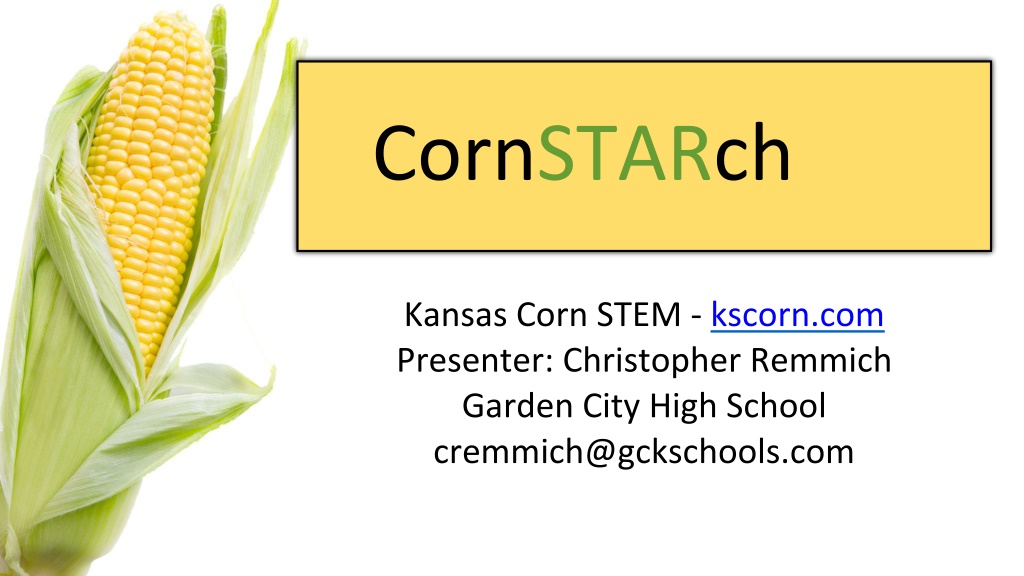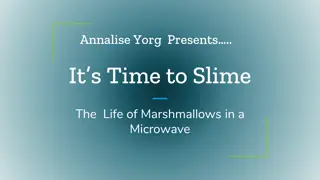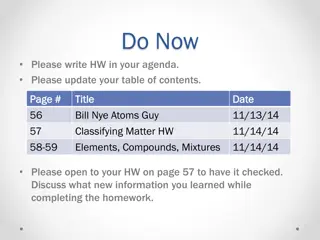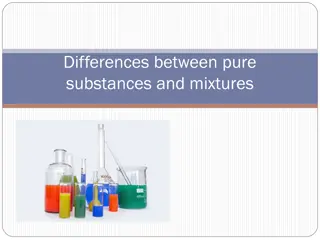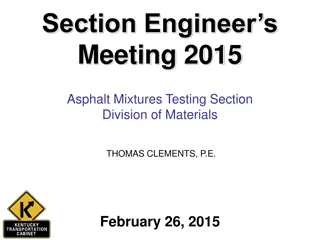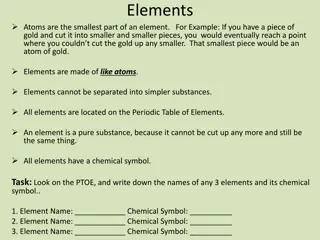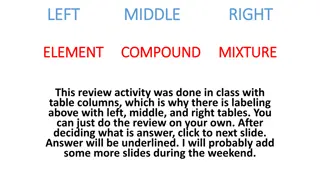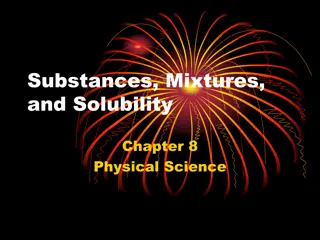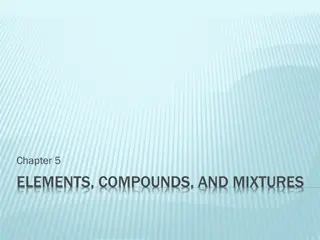Exploring the Mysteries of Cornstarch and Water Mixtures
Dive into the fascinating world of cornstarch and water mixtures with this engaging experiment. Discover the unique properties of this mysterious substance as it transitions between liquid and solid states based on external forces. Explore the science behind homogenous and heterogeneous mixtures, and get hands-on with Oobleck, a non-Newtonian fluid made from cornstarch. Unravel the secrets of this intriguing substance through interactive activities and observations.
Download Presentation

Please find below an Image/Link to download the presentation.
The content on the website is provided AS IS for your information and personal use only. It may not be sold, licensed, or shared on other websites without obtaining consent from the author. Download presentation by click this link. If you encounter any issues during the download, it is possible that the publisher has removed the file from their server.
E N D
Presentation Transcript
CornSTARch Kansas Corn STEM - kscorn.com Presenter: Christopher Remmich Garden City High School cremmich@gckschools.com
Mystifying Mysterious Mixture - Introduction Throwing it against a wall Inserting your hands in it, squeezing it and scratching it along its surface Floating a wooden block on top of the substance and hammer nails into it And ultimately comparing this substance to water and its properties 1. You have a mysterious white powder and want to test its properties. 2. For one of the tests, you decide to add water to see if it dissolves the mystery substance. 3. When you add approximately 1/4th to 1/3rd the amount of water compared to powder, you get a homogenous mixture that has the consistency of school glue, but......... 4. You notice that it has some strange properties........ 5. So, you begin to experiment and play with it by....... Stirring it slowly and then really fast Tossing it in the air Playing hot potato with your friend Placing it on the ground and hit it with a hammer
Mystifying Mysterious Mixture - Procedure 1. Each person gets a plastic cup and a popsicle stick 2. Fill your cup 1/2 - 1/3 full of the mystery powder 3. Then add about 1/4th to 1/3rd the amount of water compared to the powder 4. Stir to combine until you get the consistency of school glue 5. Play with it 6. Throw cup, popsicle stick, substance and paper towels in the trash 7. Rinse hands in the water bucket, then thoroughly wash them in the bathroom 8. This substance easily washes away with water
Mystifying Mysterious Mixture - Properties What properties did this mystery substance display? Thick-ish, glue-like consistency Liquid when moving slowly Solid when a force was applied Shattered when too much force was applied too quickly Would then return to a liquid when force was removed Would get dry and crumbly after awhile
Oobleck Named after gooey green substance from Dr. Seuss Bartholomew and the Oobleck A homogenous mixture of cornstarch and water From the corn plant and is used as a thickening agent in sauces, soups and gravies It is a starch that contains a lot of sugars linked together that like to absorb water: Straight Chain - Amylose Branched Chain - Amylopectin A Non-Newtonian Fluid
Mixtures A homogenous mixture A substance that has only one phase and looks the same throughout Kool-Aid, Vegetable Oil, Milk Chocolate, Air A heterogeneous mixture A substance that has multiple phases and is not the same throughout It has layers, parts or is chunky Salad, Pizza, Chocolate Chips Cookies, Snack Mix, Soda with Ice
Non-Newtonian Fluid A Non-Newtonian Fluid The fluid does not follow Newton s Law of Viscosity When a force is applied, the fluid becomes more liquid or solid instead of remaining constant Viscosity A substance s thickness and how easily it can flow Higher Viscosity = Thicker Fluid Lower Viscosity = Thinner Fluid
Flow Rate Flow Rate The rate at which molecules within a fluid are able to move past one another The faster the the fluid moves, the faster its flow rate Cohesive Forces (Cohesion) The attraction of similar molecules to each other Stronger Cohesive Forces = Slower Flow Rate = Higher Viscosity = Thicker Fluid Weaker Cohesive Forces = Faster Flow Rate = Lower Viscosity = Thinner Fluid
Ketchup and Cornstarch A Thixotropic or Pseudoplastic Fluid The viscous fluid becomes thinner (less viscous) over a period of time or due to an outside force or agitation Hitting or shaking a ketchup bottle A Dilatant Fluid The fluid becomes thicker (more viscous) or harder when a force is applied Hitting Oobleck or stirring it really fast
Disco Dancing Oobleck - Procedure How can Sound Waves display the properties of a Non-Newtonian Fluid? 1. Find a speaker with a decent-sized subwoofer cone 2. Cover the cone with plastic wrap 3. Color the water before adding to the cornstarch 4. Connect the speaker system to a frequency generator 5. Set the frequency to a low setting between 20 and 40 Hz 6. Set the subwoofer to its highest setting 7. Adjust the volume and the frequency of your system to get the party started! 8. Record how Oobleck behaves using the Slo-Mo feature on your phone 9. What frequency made the Oobleck dance the most?
Design the Perfect Oobleck - Procedure What ratio of Cornstarch to Water will Maximize it s Non-Newtonian properties? 1. What would the perfect Non-Newtonian properties look like? 2. How could you test for that? 3. Mass the starting amounts of Cornstarch and Water - Record in Table 4. Adjust the amounts until it passes your perfect criteria 1. Don t forget to record these additions (in grams and mL) 2. Determine the perfect ratio by dividing the total mass of Cornstarch used by the total volume of Water used.
Oobleck - Real World Applications Individually brainstorm uses of Non-Newtonian fluids Together, as a group, determine the top two most interesting Design/Sketch your useful Oobleck inspired product Develop a marketing campaign to pitch your product Try to make a prototype if possible!
Oobleck - Egg Drop Test Design an Oobleck Safety System to protect a falling egg Brainstorm possible ideas on how to protect your egg using Oobleck Use other materials provided by your instructor Choose the best idea from your group Design your Oobleck Safety System Record each height you drop your egg from Note any observations on what worked and what didn t Get as high as you can!
Viscosity Races - Procedure Determine the Flow Rate (Viscosity) of Oobleck and compare it to other household items 1. Measure out the same amount of each liquid and pour them into small cups 2. Create a Racing Board with a starting and finishing line - measure that distance and cover it in plastic wrap 3. Pour each liquid at the starting line and time how long it takes to reach the finish line. 4. Determine the substance s Flow Rate by dividing your distance travelled by the time it took in seconds. 5. Rank, in order, the fastest flow rates to the slowest flow rates
Graduated Cylinder Viscosity Test - Procedure Determine the Flow Rate (Viscosity) of Oobleck and compare it to other household items 1. Measure out the same amount of each liquid in each granted cylinder 2. Hold a marble at the top of each graduated cylinder 3. Drop it and start your timer right as it hits the top of the liquid 4. Measure how long it takes to reach the bottom of the cylinder 5. Determine the substance s Flow Rate by dividing the volume travelled by the time it took in seconds. 6. Rank, in order, the fastest flow rates to the slowest flow rates
Viscosity Cup Test - Procedure Determine the Flow Rate (Viscosity) of Corn Syrup at different temperatures - ice bath, room temperature, and warm water - using a Viscosity Cup 1. Make a viscosity cup by taking a plastic cup and making a hole in the bottom center of the cup using a nail or drill bit. Cover the hole with Duct tape 2. Place the cup on a Ring stand with another cup underneath to collect each substance 3. Fill each Viscosity Cup with the same amount of each Corn Syrup 4. Completely remove the Duct tape and record how long it takes the syrup to empty through the opening at the bottom of the cup.
Oobleck Form and Function - Procedure To observe and simulate the structure and properties of Oobleck and compare the difference between Newtonian and Non-Newtonian fluids. Part 1: 1. Make Cornstarch, but this time add sprinkles - lots of sprinkles - to the powder. 2. Mix it and stir in about 1/4th the amount of water as powder 3. The sprinkles are there to simulate the cornstarch molecules 4. Gently and slowly stir the mixture - pay close attention to the sprinkles and how they behave 5. Then quickly pull upwards to force the Oobleck to solidify around the stirrer. 6. Have a phone to record video of these interactions Use these videos to go back, zoom in and/or slow down 7. Note your observations
Oobleck Form and Function - Procedure To observe and simulate the structure and properties of Oobleck and compare the difference between Newtonian and Non-Newtonian fluids. Part 2: This part is MESSY 1. Fill three wide-mouthed plastic cups 3/4 full with the following: Water, Oobleck and Ketchup 2. Lay these cups on the ground on top of a generous amount of newspaper or plastic trash bags Or you can contain them inside a clear storage bin 3. Record video: Gently set a golf ball in each one. Record the observed behavior 4. Then, remove the golf ball and wipe it off 5. This time, drop each golf ball a little higher up - make sure they are all from the same height 6. Record video of this and document in Lab Report.
Oobleck Explanation Comic Activity To visually summarize how Oobleck works as a Non-Newtonian fluid at the molecular scale 1. Using the boxes, create a comic strip that explains how Oobleck behaves as a Non- Newtonian fluid at the microscopic and macroscopic scale 2. Be sure to include any relevant keyterms
